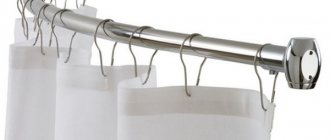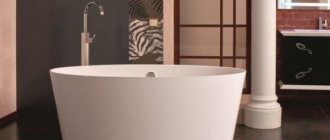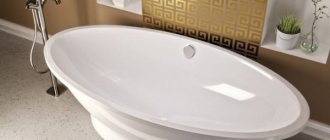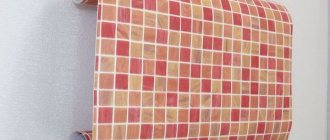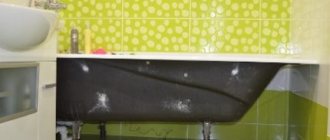Basically, the popularity of a product is influenced by a professionally done advertising campaign. The goal of the promotion is to ingrain in the minds of potential buyers the advantages of certain products over others, which is what happened with acrylic bathtubs. At the same time, other species took second place. The same applies to plastic (polymer) bathtubs, which people have become prejudiced against. In this article we will consider in detail these types of fonts, we will determine all their advantages and disadvantages.
Cast iron
A classic cast iron bathtub is the heaviest and most durable. A cast iron bathtub weighs from 100 kg and can last more than 30 years. At the factory, a cast iron bathtub is coated with enamel in several layers so that the first layer of enamel adheres well to the metal. But the presence of layers of enamel does not save it from chipping when heavy objects fall. The last (top) layer of enamel is smooth and shiny. To avoid falls in the bathtub due to its slippery bottom, you can use a special coating. The water in a cast iron bath does not make noise and takes a long time to cool down. Cast iron takes a long time to heat up, but does not conduct heat. The water cools to room temperature within an hour and a half. The complex casting process of cast iron offers bathtubs of simple designs and shapes. Bathtubs made from other materials may cost less and have a more interesting shape, but a cast iron bathtub will last the longest.
Options for standard rooms
But it should still be recognized that not all potential buyers are ready to postpone the purchase of such an extravagant product until the time when they theoretically acquire a three-story cottage, where an entire floor will be dedicated to the bathroom.
That is why acrylic bathtubs with glass are so popular today for standard apartments in city high-rises.
Corner bathtub with glass for standard apartments
A word of caution: having decided to purchase such an exquisite product, you should understand that a corner bathtub with glass will look good in the interior only if there are items worthy of its status.
Such products have a minimal number of glass elements on the front side, but, nevertheless, it adds extravagance to the entire room.
And, nevertheless, this effect requires strengthening, otherwise the glass insert will look foreign.
Glass bathroom furniture as an addition
Accessories such as:
- glass (plastic transparent) glasses for oral hygiene;
- glass soap dishes or their colored analogues;
- glass bathroom sinks;
- bathroom shelves for hygiene products and shampoos with glass elements;
- traditional mirror;
- unusually shaped lamps with glass decorative elements, etc.
Steel
The stainless steel bathtub is coated with enamel at high temperatures, so the enamel does not peel off. If the bathtub is covered with quartz enamel, then the bathtub is not in danger of scratches. Under excessive load, a steel bathtub can become deformed and the enamel can crack. The wall thickness of the durable steel bath is 3 mm. Steel bathtub is popular in the market due to its low cost and light weight. Although, it is the lightness of the steel bath that is the main reason for its disadvantages. The water in the steel bathtub fills too noisily and cools too quickly. To eliminate noise, the outer side of the bathtub is covered with penofol, sheet rubber or rubber. Also, as a sound insulator, a layer of polyurethane foam can be applied to the outside of the walls and bottom of a steel bathtub. The weight of a good steel bath varies from 30 to 50 kg. Steel is malleable, which is why there are many different models and shapes of steel bathtubs on the market.
Why do they buy baths of this type?
Let's find out why a bathroom with glass, or one entirely made of such a fragile material, attracts buyers.
The most reliable way is to find out the concept of manufacturers who are actively promoting these products in the plumbing market.
The domestic market offers products from European, Asian and Russian companies, whose models contain glass elements or are made entirely of glass:
- Akvarodos,
- Albatros,
- Axor,
- Akwella,
- Burgbad,
- Duravit,
- Ideal Standard,
- Novellini,
- Frap,
- Jorger,
- Gemelli,
- Waterlounge,
- HST,
- Nautico,
- Lamxon,
- Lemen,
- Pharo,
- Villeroy&Boch,
- Verona and others.
Almost all of them position bathrooms made of glass as places of relaxation.
And to confirm this concept, many models are offered to consumers with a host of additional accessories:
- hydromassage equipment;
- air massage elements;
- submersible loungers made of moisture-resistant materials;
Submersible lounger made of natural waterproof material
- built-in acoustic and multimedia systems (radio, TV);
- special illumination with changing characteristics, controlled by a digital processor; additional accessories for aromatherapy (in particular, boxes for storing aromatic oils, oil dishes, lamps in the same style, holders, etc.).
Bathroom with built-in TV
Acrylic
Acrylic bathtubs appeared in the 90s and filled the market with a wide variety of shapes and models. Acrylic is as light as steel, but the water in an acrylic bath takes much longer to cool down. An acrylic bathtub weighs from 15 to 35 kg. Acrylic bathtubs come in “cheap” and “expensive” varieties. The quality of the bathtub depends on the quality of the acrylic and the number of layers of reinforcement. Acrylic bathtubs not only come in a variety of shapes and models, but also in all colors. Acrylic cools slowly and deforms at high temperatures. Deteriorates from powerful chemicals. Use non-powder products and products without any solvents. Acrylic is not slippery, but is susceptible to scratches. Shallow scratches can be removed with sandpaper. With proper care, an acrylic bathtub can last 12 years or more.
Let's sum it up
In conclusion, I would like to say that an acrylic bathtub is a reliable and durable product that will last (subject to careful use) for decades. The main condition for its durability is to wash it with special products for acrylic, and not to fill the bath with boiling water, solvents or gasoline.
In other cases, the bath will pleasantly surprise you, because lying down in a surface that is warm and pleasant to the touch, what could be more pleasant? And for lovers of long water procedures, an acrylic bathtub will become an indispensable assistant, since the collected water will not cool down for a very long time.
Quarilovaya
Compared to others, an expensive bathtub made of a mixture of acrylic and quartz is resistant to mechanical stress. Thanks to modern manufacturing materials: in such a bath the water cools down for a long time; many models are installed without a power frame; there are non-standard bathtub models; In terms of service life, quarryl bathtubs are not inferior to acrylic ones. But a quarryl bathtub is also sensitive to too high a temperature, like an acrylic one. The main disadvantages of a quaril bath are its high cost and heavy weight. It weighs a little lighter than a cast iron bathtub.
Benefits of a bath
A bathtub made of glass has undoubted advantages, despite its apparent fragility and extravagance.
For example:
- it does not clutter up the space. And although most bathtub models are large in size, they nevertheless look quite light and weightless;
- it is aesthetically pleasing due to its transparency. A glass bathtub looks great, which is why it is often installed in the center of the room;
- she is easy to care for. Indeed, liquid detergents and a soft sponge are enough to tidy up the bathtub after water procedures;
- it is environmentally friendly and hygienic. It is difficult to find a purer and more inert material than glass. With proper care, colonies of pathogenic microbes will never appear on its surface, and a whitish coating or rust will not form.
Advice!
Although a glass bathtub is considered a product for large spaces, it can also be placed in a smaller room.
For small spaces, the best location would be to install the bathtub close to the wall, for which you should choose the appropriate model.
Fiberglass
A modern approach to creating lightweight and durable bathtubs. Fiberglass bathtubs are silent and non-slippery. They heat up quickly and the water remains warm for a long time. Therefore, fiberglass hot tubs and hot tubs are in great demand in the market. Fiberglass is not inferior in strength to steel and weighs several times lighter. Due to the complex creation process, fiberglass bathtubs are more expensive than previous ones. Thanks to the top protective layer of gelcoat, fiberglass bathtubs are not afraid of high temperatures, scratches and chemicals. The service life of a fiberglass bathtub is 15 years. Rescue boats, yachts, swimming pools, etc. are also made from fiberglass.
How to restore a bathtub to its original appearance?
self-filling bath
There are several ways to “make” this essential piece of furniture shine again. The most famous of them are:
- enamelling;
- pour-in bathtub.
To implement the first method, the market today offers a large number of different enamels of acrylic origin. They can be successfully used to paint both cast iron and acrylic bathtubs. However, a significant disadvantage is that the surface repaired in this way can peel off after just a few months of use.
How to navigate existing drainage systems
Before you begin repairing and restoring a bathroom, you should know that it can be divided according to the type of system into internal and external drainage systems. It can also be made from polymer and metal materials. The seal can also be either rubber or adhesive.
Ceramic
Ceramic baths are metal-ceramic and earthenware. Making such a large object from ceramics and firing it in such dimensions requires large costs for the production of ceramic baths. Therefore, a faience bathtub is one of the most expensive types of bathtubs. It is made from the highest grade of white clay. A ceramic-metal bathtub costs much less than a faience bathtub because it consists of a metal frame and a smaller amount of expensive white clay. Ceramic baths are fired and coated with a layer of acrylic glaze to prevent air and steam from being absorbed into the clay. Thanks to glazing, ceramic baths have a perfect glossy and smooth surface. Water in a ceramic bath is drawn without noise and cools down for a long time. Due to the complex creation process, ceramic bathtubs are made in classic oval shapes. Clay baths come in white, blue, milky and turquoise colors. The disadvantages of ceramic baths include their high cost, heavy weight and instability to cracks and chips. With careful use, ceramic bathtubs can last no less than other types of bathtubs.
Mixture selection
There are 2 composition options for coating a cuvette using this method: liquid acrylic and stacrylic.
The mixtures are somewhat similar, but they also have differences. Glass foam foams when applied, you need to constantly remove bubbles with a roller or brush. If this is not done, porosity will be noticeable when drying. Liquid acrylic does not foam, is easier to apply, dries faster, has fewer defects when drying, but is more expensive.
Glass acrylic has been used for restoring bathtubs for a long time, for more than 10 years. He performed quite well. But in recent years, cutting-edge materials have appeared that have more advantages.
The glass bathtub dries out within 4 days, all this time spreading an unpleasant heavy odor. There are also some restrictions when using it: it is not recommended to place metal objects (basins, buckets) in it, or to bathe animals with sharp claws.
Liquid acrylic is the newest material that appeared 3 years ago. It is smoother, mirror-like than glass and more resistant to all kinds of mechanical microdamage. In addition, it dries within 2 days and does not emit any odor.
Advantages of a self-fill bath.
The main difference between enamel and liquid bath mixture is the different application. To apply enamel, first the cuvette is thoroughly cleaned and then coated with two layers of enamel. If this piece of plumbing had any flaws, for example, low-quality casting, then a layer of enamel will not hide them; they will still be visible. And if there was rust on the bottom, then after a year of use it will appear again and you will have to re-coat the bottom with enamel.
But glass acrylic is applied in a thick layer, and thanks to this, all defects will be hidden and such a cuvette will last a long time. The pre-prepared surface is covered with acrylic, and under its weight it fills all the cracks and chips. In addition, the stacrylic bathtub has a springy effect, since the thickness of the composition on the bottom reaches 6-7 mm, and on the side surface – up to 3 mm. If you accidentally drop the shower head, there will be no chips.
Marble
Luxurious bathtubs made of natural marble are expensive, but their appearance completely justifies their cost. Beautiful bathtubs are also made from artificial (cast) marble, the cost of which is similar to the price of acrylic or cast iron. Bathtubs made of natural and artificial marble are silent and resistant to different temperatures. Marble retains the heat of water well. Oddly enough, bathtubs made of cast marble have an advantage over bathtubs made of natural marble. Natural marble bathtubs are made by carving a solid stone, which results in cracks and scratches in the surface of the marble. A bathtub made of artificial marble is made by casting a homogeneous material, which results in a bathtub without scratches or cracks. Cast marble bathtubs are coated with gelcoat to protect surfaces from dirt, damage and high temperatures. Bathtubs made of natural light marble become stained or yellow over time due to water or cosmetics and household products. Also, marble baths require constant care and restoration in places where chips and cracks form. A marble bathtub is usually made to order, and its shape depends entirely on your imagination and financial capabilities. When buying a bathtub, do not forget to pay attention to its dimensions and volume: length, width, height. Choose the most comfortable option for you, which can also fit comfortably in your bathroom. And if you need the help of a plumber, then find him for free in the Ustabor.uz catalog of masters.
Authors and inspirers of glass products
In a word, a glass bathtub is an element of pleasure, and not an exclusive sanitary fixture. And in this approach lies the main difference between glass products for the bathroom and all others.
And then, for some reason, the possibility of creating bathtubs from colored glass is forgotten. Yes, these are designer things, but in fact, similar models are in the catalogs of all manufacturers, as well as a fiberglass bathtub, a quarry bathtub, and one made of natural wood, stone and a number of others, to the creation of which famous people contributed their talent.
Just for clarity, it is glass models in the traditional sense of transparent glass that can most often be seen at the stands of the above companies.
Blue glass bathtub
Another interesting feature of unique colored bathtubs is that most products made of colored glass have in their names a mention of famous designers who had a hand in their creation.
We hear such recognized masters as
- Dominic Tessero;
- Philippe Starck;
- Sergio Chobani,
- Michael Graves
- Massimo Iosa Ghini,
- Dieter Sieger,
- Norman Foster
- design duo Phoenix Product Design and other equally famous personalities.
Designer curved red glass bathtub by architect Michael Graves
Yes, such things are insanely expensive. But it is they who force mass producers to adopt ideas and implement them in simpler products.
This trend is well known and encouraged, since it forces manufacturers to annually offer customers more and more new forms of well-known things, for example, numerous variations of the same classic bathtub.
Conclusions: a glass bathtub, despite its apparent fragility, is a fairly durable product designed to create a special charm in the bathroom. And having decided to purchase such an exclusive product, the owners will never regret the money spent in the future.
What is fiberglass
The operating principle underlying the strength of fiberglass is similar to reinforced concrete, and in appearance and structure it is closest to the reinforced layers of modern “wet” facade finishing. As a rule, the binder - composite, gypsum or cement mortar - tends to shrink and crack, not holding the load, and sometimes not even maintaining the integrity of the layer. To avoid this, a reinforcing component is introduced into the layer - rods, meshes or canvas.
The result is a balanced layer - the binder (in dried or polymerized form) works in compression, and the reinforcing component works in tension. From such layers based on fiberglass and epoxy resin, you can create three-dimensional products, or additional reinforcing and protective elements.
The essence of the pouring method
bathroom restoration
Another name for this method is poured glass bath. It is a method of treating the surface of used equipment in which a new liquid acrylic layer is applied to a used container made of any material.
The result allows you to get new pleasant and absolutely superior tactile sensations to the previous ones. The new coating will not have the old pores. Such a smooth surface is easy to clean with any cleaning agent.
Is restoration necessary, how to determine?
In what cases will creating a self-fill bath allow you to save money on purchasing a new product? You can determine this yourself by analyzing the following points:
- The old coating became very rough.
- There are microcracks on the surface.
- Rust formation.
- There are water stains on the bathtub, and the original shine and color have disappeared.
If your bathtub has at least one of the listed “symptoms,” then you can begin its restoration.
General information on the issue
When it comes to these types of baths, we need to divide them into three groups:
- Cast type marble . It looks like natural stone, and is also characterized by high strength, absence of stains, and resistance to aggressive environments. The bath can be made in any shade and also vary in shape.
- Starilan . The component is created to combine all the main characteristics of acrylic and steel. The outside surface is covered with acrylic, and the base is a steel mold. The case has a good level of comfort and convenience.
- Kvaril . Another new development, which includes an acrylic component and quartz powder. Products are usually made in steel molds that will be perfectly polished. The bathtub will be removed from the mold without the need for additional sanding.
But at the same time, each of these materials has both its advantages and disadvantages. It is best to consider them so that the purchase does not bring unexpected shortcomings in the future.
Do it yourself!
Both on the Internet and offline, the self-filling bathtub received the most excellent reviews. Customers of the service are delighted with the result. And the masters unanimously speak about the ease of execution. It turns out that making such a liquid coating is quite possible on your own. To do this, it is enough to adhere to a certain algorithm for performing work.
To begin, you will need to prepare the following:
- the composition itself for the filling bath;
- rust or plaque remover;
- cleaning powder;
- grinding material;
- brush with soft bristles.
DIY restoration
The work itself will consist of the following stages:
- The container is prepared for applying the composition. To make the surface ready for work, you need to apply an anti-corrosion agent to the bath. In this case, you must strictly follow the instructions indicated on the packaging.
- Now you need to sand it down to a matte finish. After which everything is cleaned with powder and washed with plenty of water.
- Then the bathroom will need to be thoroughly dried. After this, it will be enough to go through the solvent in order to dry it.
- Now you need to prepare the composition. Add the hardener to the jar containing the base and mix thoroughly for five minutes.
- The material should be left for ten minutes - during this time it will have time to acquire the desired consistency. After this, all that remains is to apply it carefully to the bath. You need to start from the sides and gradually move down in a spiral.
Repair specialists give one practical piece of advice: for the first time, you need to purchase more composition than the calculations show. And most importantly, the composition will harden within an hour, so its application must be completed within this time period.
Recovery process
Now the time has come for the most responsible and important stage - restoring the bathtub. Mix liquid acrylic with hardener. Mix the ingredients well for 15 minutes until a homogeneous mass is obtained. Due to this, the components of the mixture will interact with each other.
First of all, apply the finished acrylic to the sides of the product. Next, distribute the layer evenly down the spiral. This work must be done very quickly, as the composition may harden.
If you do not have experience in making a pour-in bathtub, buy the basic components with a reserve. This will allow you to definitely finish the job without worrying about not having enough mixture.
As for the correct calculation of the consumption of liquid acrylic, on average 3.5 kg is needed for one bath.
Adding color
If you want to add color to a sanitary ware, then the appropriate color is simply added to the liquid acrylic. This way you can achieve the desired shade. However, you will not achieve rich color, since liquid acrylic has some distinctive technological features. If after a while you want to change the color again, then add the desired color to the liquid acrylic and fill it again.
So, we learned from this article how to make a self-filling bathtub yourself. If you liked this technology and have already implemented it at home, then write your opinion in the comments to this article.

